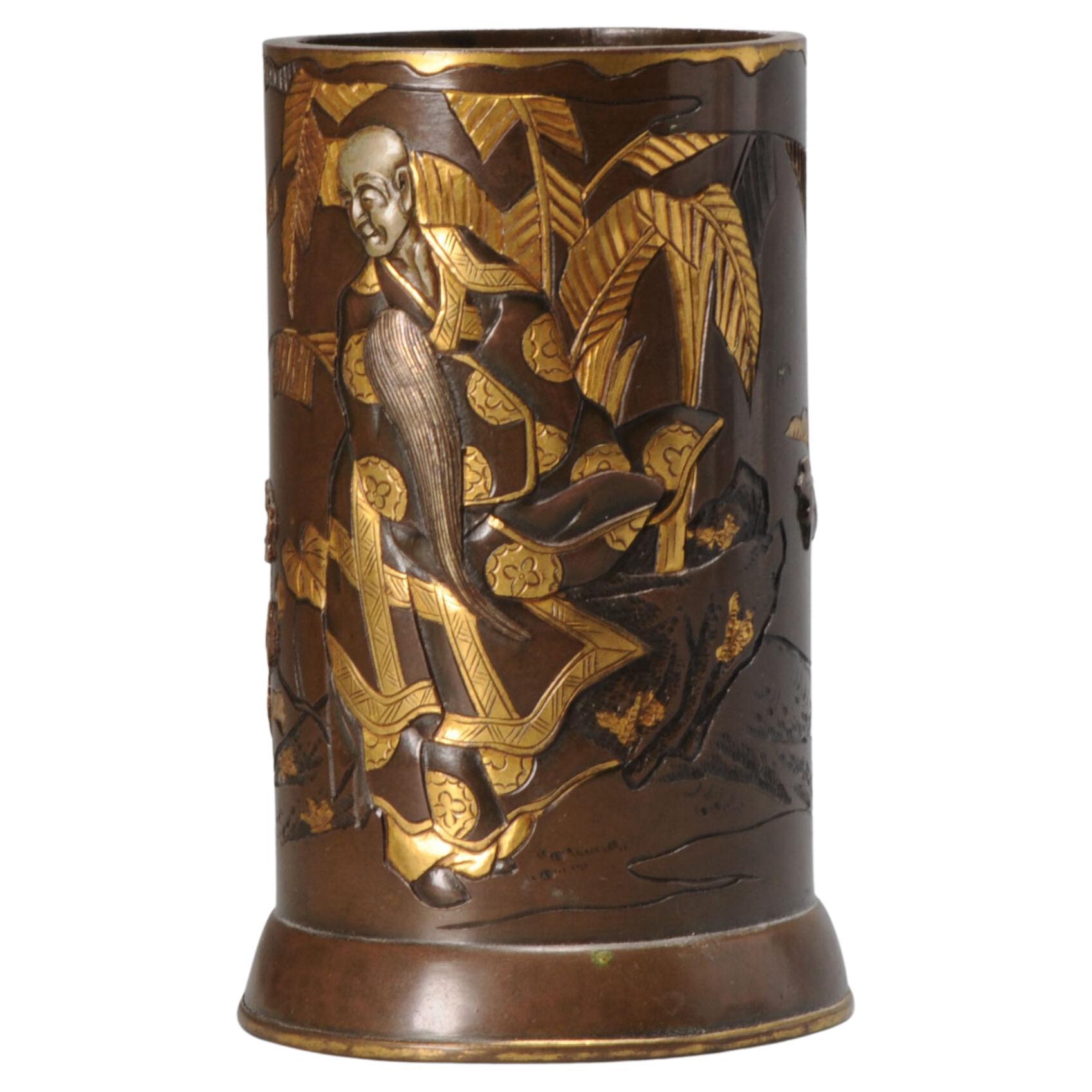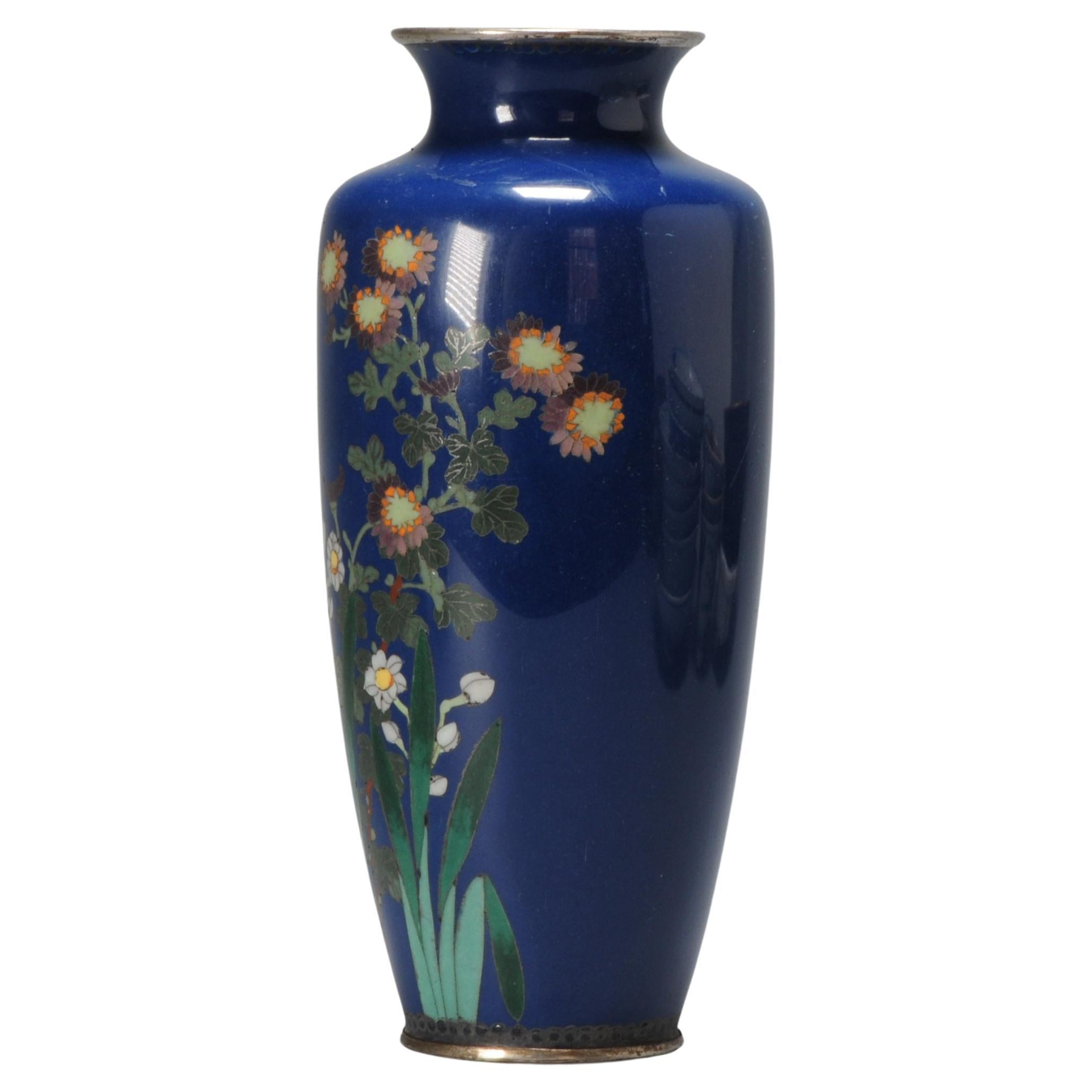Items Similar to Inlaid Shibuichi Vase in Lovely Shape, Landscape, Meiji Era
Want more images or videos?
Request additional images or videos from the seller
1 of 12
Inlaid Shibuichi Vase in Lovely Shape, Landscape, Meiji Era
About the Item
Japan, silver inlaid bronze vase, Meiji period (1868-1912), the bulbous vase inlaid with a temple in a landscape,
28-6-22-1-12
Condition
no real damages found, just a small process flaw in base and some ware. Size 130x120mm Height x Diameter
Period
20th century Meiji Periode (1867-1912)
Taisho Periode (1912-1926).
- Dimensions:Height: 4.73 in (12 cm)Diameter: 5.12 in (13 cm)
- Style:Qing (Of the Period)
- Materials and Techniques:
- Place of Origin:
- Period:
- Date of Manufacture:19th Century
- Condition:Wear consistent with age and use. Minor losses.
- Seller Location:Amsterdam, NL
- Reference Number:1stDibs: LU4863233264922
About the Seller
5.0
Gold Seller
These expertly vetted sellers are highly rated and consistently exceed customer expectations.
Established in 2015
1stDibs seller since 2019
158 sales on 1stDibs
Typical response time: 9 hours
- ShippingRetrieving quote...Ships From: Amsterdam, Netherlands
- Return PolicyA return for this item may be initiated within 14 days of delivery.
More From This SellerView All
- Inlaid Shibuichi Bitong / Vase in Lovely Shape, Landscape, Meiji 19th CLocated in Amsterdam, Noord HollandMeiji Period (1868-1912), Japan A small brush pot with an inaid scene of a man standing in a garden. Marked on the base with five impressed characters. Condition Very good...Category
Antique 18th Century Chinese Qing Ceramics
MaterialsPorcelain
- Inlaid Shibuichi Vase in Flower Shape Cranes, Meiji '1868-1912' Era, EarlyLocated in Amsterdam, Noord HollandThe scalloped vase (shape of a flower) inlaid with cranes on the waterfront. Beautiful craftmenship. Unmarked. Perfect condition. Size 120mm high ...Category
Antique 19th Century Japanese Qing Ceramics
MaterialsPorcelain
- Shibuichi Vase in Lovely Shape, Landscape, Meiji (1868-1912) Era, Early 20th CLocated in Amsterdam, Noord HollandJapan, silver inlaid bronze vase, Meiji period (1868-1912), the bulbous vase inlaid with a temple in a landscape, Additional information: Material: Bronze & Cloisonne Region of Orig...Category
Early 20th Century Japanese Vases
MaterialsBronze
- Pair of Round Cloisonné Enamel Vases Meiji Era '1868-1912' DragonsLocated in Amsterdam, Noord HollandTop quality Meiji era (1868-1912), 19th century Each vase worked in gilt and wire of varying gauge with a mirrored design. Condition Vase one with some missing enamel/glaze spo...Category
Antique 19th Century Japanese Qing Ceramics
MaterialsPorcelain
- Small Vase with Flowers on Blue Cloisonné Enamel Meiji Era '1868-1912'Located in Amsterdam, Noord HollandTop quality Meiji era (1868-1912), 19th century Interesting article about Japanese Cloisonne can be found here; Condition Some usage signs, all pictured. Size 183mm high Per...Category
Antique 19th Century Japanese Qing Ceramics
MaterialsPorcelain
- Lovely 19c Antique Meiji Period Japanese Ginbari Bronze Cloisonne VaseLocated in Amsterdam, Noord HollandDescription Lovely and beautifully made piece. With a stunning scene of a crane Cloisonné is an enamelling technique in which the pattern is formed by wires soldered to the surfa...Category
Antique 19th Century Japanese Meiji Ceramics
MaterialsPorcelain
You May Also Like
- Magnificent Antique Japanese Satsuma Vase, Meiji Era, SignedLocated in London, GBA fine antique Japanese Satsuma vase. Meiji period. Signed. A very nice 19th century Japanese Satsuma ware vase of a relatively ...Category
Antique Late 19th Century Japanese Ceramics
MaterialsCeramic, Porcelain
- Pair Of Seto Porcelain Covered Vases, Japan Meiji EraLocated in Saverne, Grand EstMagnificent pair of porcelain vases with a rich underglaze blue decoration of a couple of partridges among the vegetation. A minimal defect on each interior lid in the shape of a sty...Category
Antique Late 19th Century Japanese Meiji Ceramics
MaterialsPorcelain
- A magnificent antique Japanese cobalt blue Satsuma Vase by Kinkozan. Meiji EraLocated in London, GBA magnificent Japanese Satsuma Vase of a slender ovoid form decorated with an extensive landscape and chickens amongst a bamboo trees. Signed by Kinkozan. Meiji period. Size H. 24...Category
Antique Late 19th Century Japanese Ceramics
MaterialsCeramic
- Set of Two Japanese Cloissoné Vases Meiji Era Dragon and PheonixLocated in Knivsta, SEA pair of Japanese cloisonné enamel vases. Meiji era Japan (1867-1912), a period marked by rapid transformation of Japanese traditional society into a global power. The period of gro...Category
Antique Late 19th Century Japanese Meiji Ceramics
MaterialsEnamel
- Antique Japanese Meiji Era Porcelain Satsuma Figural Kutani Vase Fu Dogs GeishaLocated in Dayton, OH"Late Meiji era Kutani vase, circa 1903. A beautiful porcelain blue ground centered by an intricate Geisha flanked by gold figural Foo Dog handles. Features a floral and foliat motif throughout. Signed along the base. Kutani ware, Japanese porcelain made in Kaga province (now in Ishikawa prefecture). The name “Old Kutani” refers to porcelain decorated with heavily applied overglaze enamels and produced in the Kaga mountain village of Kutani. The powerful Maeda family had established a kiln there by 1656. The clay bodies used were gray and coarse-grained. On most pieces—dishes and bowls were especially common—a white or blue-white matte glaze was decorated in dark, restrained colours, initially greens, yellows, and some reds, and later purples and dark blues. Some items had cobalt blue decoration under a white glaze. The most noted Old Kutani pieces are “Green Kutani,” in which most of the surface is covered in a green or blue-green glaze to which one or two colours have been added (or the glaze is applied evenly over a design executed in black). The bold designs of Kutani ware drew freely from Chinese ceramics, paintings, and textiles. They are renowned for their rich pictorial ornament executed in lively, intense lines. Owing to local financial problems and difficulties in obtaining the necessary pigments, the Kutani kiln was abandoned some time in the Genroku period (1688–1704). Ceramics production in Kaga enjoyed a renaissance early in the 19th century, however, including the establishment of another kiln at Kutani in the 1820s. In addition to a revival of the styles of Old Kutani ware, there arose a style using gold on a coral-red ground, which was perfected during another spate of activity that began in the 1860s. Technical advances were made and Western-style pigments were adopted, and by the 1890s modern Kutani...Category
Antique Early 1900s Meiji Vases
MaterialsPorcelain
- Japanese Satsuma Earthenware Dish, Meiji Era JapanLocated in Saverne, Grand EstExceptional Satsuma earthenware dish of incredible finesse. A work of art which, without a doubt, required several dozen hours of meticulous work. But what a result !!! Japan around ...Category
Early 20th Century Japanese Ceramics
MaterialsEarthenware





